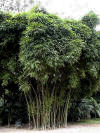|
bamboo
Giant plant, that belongs to the family of
grasses and with the botanical name Bambusa vulgaris.
With the exception of
some species, such as Calcutta Bamboo (Dendrocalamus strictus),
bamboo typically
has a hollow stem, made up of jointed segments, often with a natural film of a
fine, whitish powder-like substance, called
nuan
in Thai, on its surface. Its elongated leaves are of a glossy green
to yellow colour, depending on the variety (fig.)
and season. Its shoots (fig.),
called no mai phai (หน่อไม้ไผ่) in Thai, are edible and its flexible
timber is an important building material, especially in rural areas
and among the hill tribes. Bamboo is the fastest growing of all
plants on earth, with some species growing a whole meter in a single
day and able to grow up to 30 meters tall. Since bamboo grows
rapidly and has a very slow putrefaction process, it makes a very
appropriate construction material in any humid environment and
climate. Its hollow stem is used amongst others used to make huts,
rafts, pipes for water supply, fences, etc. By splitting the
cylindrical trunk it can be unfolded and used as to make floors (fig.),
walls, mats, etc. This split, unfolded bamboo is in Thai known as
reuak.
Besides this, the separate compartments are very suitable to make
all kinds of utensil, such as water and food containers, water
pipes, animal fodder trough, etc. There are many different
varieties, of which some are popular ornamental plants. In Chinese
mythology bamboo is a symbol for longevity and the word in Chinese
is homonym with another character meaning ‘to invoke, to pray to, to
wish’ and ‘to express good wishes’. Because of this, as well as its
durability, strength, flexibility and resilience, bamboo has hence
become a Chinese symbol of longevity and can often be seen in
Chinese art and architecture (fig.).
Since it survives in the harshest conditions, staying green all
year-round, it shows us that the secret of a long happy life is to
go with the flow. In
feng shui,
it is suggested to put bamboo plants in the front of homes to assure
its inhabitants a long life.
The fact that Chinese
was traditionally written vertically, i.e. from top to bottom,
is that prior to the invention of paper, books in Ancient China were
written on strips of flattened bamboo that were joined together with
thread into long rows that could be rolled up into cylinders and
wrapped in cloth.
Most bamboo plants flower infrequently,
i.e. generally only once every couple of years and some species even
at intervals as long as 120 years. As such, blooming bamboo (fig.)
is an extremely rare sight.
In Oriental
iconography and
art,
bamboo is the symbol for
summer and one
of the
Four Sacred Symbols.
In Korea, common sea salt is roasted nine times in bamboo containers
at high temperature to obtain jugyeom (죽염), i.e.
‘bamboo salt’ or purple salt, from which impurities are removed or
neutralized while its inorganic contents are increased, making it
more healthy than ordinary table salt.
In Thai
called
phai and
mai phai, as well as
welu, and in Chinese known as
zhu.
See also
TRAVEL PICTURES
and
WATCH VIDEO.
回






|

